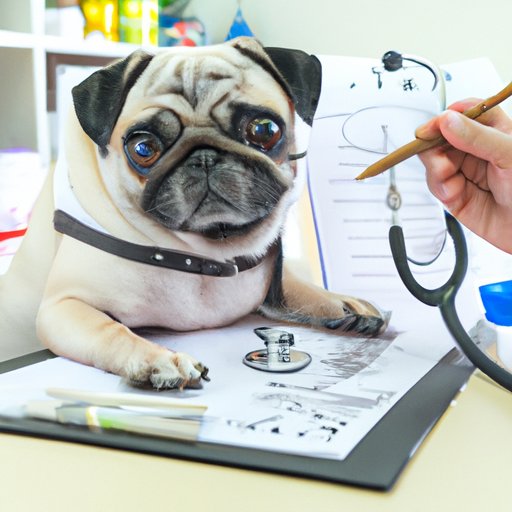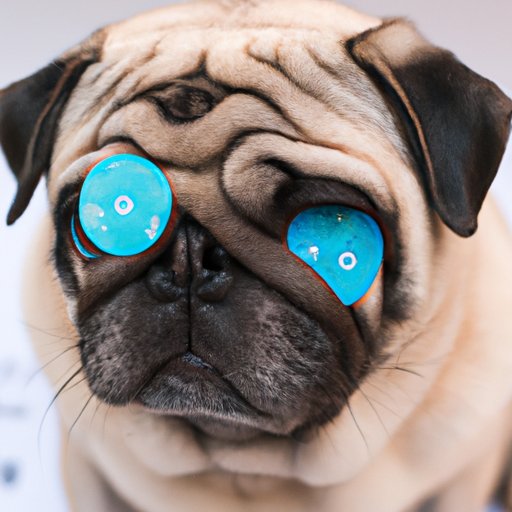Introduction
Pugs are one of the most beloved dog breeds around the world. They’re small, affectionate, and have an endearing personality that can win over anyone’s heart. But pugs also come with their own set of health problems. This article will explore what these health issues are, how they can be prevented, and what you should do if your pug develops any of them.
Exploring Common Health Issues in Pugs
Pugs are prone to certain health problems due to their brachycephalic (short-nosed) face shape. Some of these issues include:
Brachycephalic Syndrome
Brachycephalic Syndrome is a condition that affects many flat-faced breeds such as pugs, Bulldogs, and Shih Tzus. It causes difficulty breathing because the airway is narrow and obstructed by the presence of extra tissue in the throat. Symptoms include snoring, snorting, and labored breathing. If left untreated, it can lead to serious complications such as collapsed trachea or heat stroke.
Eye Problems
Pugs typically have bulging eyes, which can make them more prone to eye problems. These include dry eye, corneal ulcers, and entropion, which is when the eyelid rolls inward and rubs against the eyeball. These issues can cause irritation and pain, so it’s important to take your pug to the vet if you notice any symptoms.
Skin Conditions
Pugs can develop skin conditions, such as dermatitis and mange, due to their sensitive skin. These conditions can cause redness, itching, and hair loss. Regular grooming and bathing can help keep your pug’s skin healthy and prevent these issues from occurring.
Allergies
Pugs can also suffer from seasonal allergies, just like humans. Symptoms include sneezing, coughing, and itchy eyes. Allergies can be managed with medications, but it’s important to consult a vet first before giving your pug any medication.
A Veterinarian’s Guide to Pug Health Problems
Taking your pug to the vet regularly is one of the best ways to keep your pet healthy. Your vet can do a physical examination to check for any health problems and provide advice on how to keep your pet healthy. Here are some things your vet may recommend:
Regular Checkups
Your vet will likely recommend regular checkups to monitor your pug’s health. This includes checking for any signs of illness or disease, as well as doing routine tests such as blood work and X-rays. Regular checkups are important to ensure your pug stays in good health.
Vaccinations
Your vet will also likely recommend vaccinations for your pug. Vaccines protect against a variety of diseases, including parvovirus, distemper, and rabies. Talk to your vet about what vaccines are right for your pug and follow their recommendations.
Diet and Exercise
A balanced diet and regular exercise are key to keeping your pug healthy. Your vet can recommend the best food for your pug based on their size, age, and activity level. Additionally, it’s important to make sure your pug gets enough exercise each day. Take them for walks or play fetch in the yard to keep them active.

The Pros and Cons of Owning a Pug
Owning a pug can be an incredibly rewarding experience, but it comes with its own set of pros and cons. Here are some of the advantages and disadvantages of having a pug:
Advantages
Pugs are loyal and affectionate companions who love spending time with their owners. They’re also low maintenance and don’t require much exercise. Plus, they don’t shed much, making them ideal for people with allergies.
Disadvantages
Pugs are prone to health problems due to their brachycephalic face shape. They can also be difficult to house train and can be quite noisy. Additionally, they can be expensive to maintain due to their medical needs.

Diagnosing and Treating Pug Health Problems
If your pug is showing signs of illness or injury, it’s important to take them to the vet right away. Your vet will conduct a thorough examination and may order diagnostic tests such as blood work or X-rays to determine the cause of your pug’s symptoms. Once the diagnosis is made, your vet will discuss treatment options with you.
Diagnosis and Testing
Your vet will likely perform a physical exam and discuss your pug’s medical history. They may also order additional tests, such as blood work or X-rays, to get a better understanding of your pug’s condition. These tests can help diagnose the cause of your pug’s symptoms and provide insight into how to treat them.
Treatment Options
Depending on the diagnosis, your vet may recommend medications, surgery, or other treatments. For example, if your pug has allergies, they may suggest antihistamines or other allergy medications. If they have an eye problem, they may need surgery to correct the issue. Your vet will discuss the best treatment option for your pug.
Understanding the Genetics Behind Pug Health Issues
Many of the health issues associated with pugs can be traced back to their genetics. In recent years, there has been a push to breed healthier pugs through genetic testing and responsible breeding practices.
Breeding Practices
Responsible breeders are aware of the health issues that affect pugs and are careful to only breed dogs that are free of any genetic health problems. This helps reduce the risk of passing on any health issues to puppies.
Genetic Testing
Genetic testing can also be used to identify potential health problems in pugs. Tests can detect genetic markers associated with certain diseases, allowing breeders to avoid mating dogs that carry those genes. This helps reduce the risk of passing on any health issues to puppies.

How to Care for Your Pug to Avoid Health Problems
While pugs are prone to certain health problems, there are steps you can take to prevent them. Here are some tips for keeping your pug healthy:
Proper Nutrition
Feeding your pug a balanced diet is essential for their health. Talk to your vet about the best foods for your pug and make sure to provide them with plenty of fresh water. You may also want to consider adding supplements to their diet, such as omega-3 fatty acids, to help support their immune system.
Exercise
Regular exercise is also important for keeping your pug healthy. Take them for daily walks or play games with them in the yard to keep them active. This will help keep their weight under control and prevent boredom, which can lead to destructive behaviors.
Grooming
Grooming your pug regularly is also important. Brush their fur to remove any dirt or debris and check for any signs of parasites. Additionally, trim their nails regularly to prevent them from growing too long and causing discomfort. Finally, check their ears for any signs of infection, such as redness or discharge.
Conclusion
Pugs are lovable companions, but they’re also prone to certain health issues due to their brachycephalic face shape. It’s important to be aware of these issues and take steps to prevent them, such as taking your pug to the vet regularly, feeding them a balanced diet, and providing them with regular exercise. By taking these steps, you can help ensure your pug stays happy and healthy for years to come.
(Note: Is this article not meeting your expectations? Do you have knowledge or insights to share? Unlock new opportunities and expand your reach by joining our authors team. Click Registration to join us and share your expertise with our readers.)
